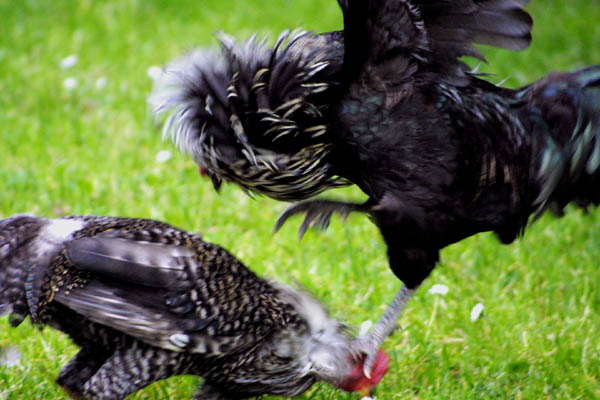Break it up!

Image: Break it up!:Photo by Barrett Lyon/State Hornet:
March 20, 2002
Two roosters are lucky to be alive after a Facilities Management worker broke up their battle on campus last week.
Otha Swanigan, a facilities management worker, said he was looking out the window of the Central Plant office on March 12, at 4:30 p.m., when he saw two of the campus roosters “about to square off.”
When Swanigan got outside, a group of maintenance workers had started to gather to watch the action near the water tank. Swanigan said the fight started to get out of hand, so he had to take action quickly.
“I just went out there and picked them up,” Swanigan said. “I saved the roosters? lives. We would have lost one of them.”
Swanigan said that he usually doesn?t see roosters fighting on campus.
“I think they must have been crossbred or something,” Swanigan said.
Patrick Foley, a professor of biology, said that one type of chicken, the Road Island Red, is not usually aggressive in nature.
He said the male roosters are competitive due to their social structure, which consists of the males having harems of female chickens.
“Usually roosters fight over female chickens and to declare their territory,” Foley said.
The origins of the chickens that live on campus are a mystery, but students and faculty offering their own unique versions of the story.
Anthony Kolitsos, a senior at Sacramento State, said he heard that the chickens were part of a science experiment that went out of control.
“I heard that it was an experiment to see how the population would grow,” Kolitsos said.
Sophomore Maria Gonzalez offered a different explanation.
“Someone told me that we stole them from a rival school and that is why they are here,” Gonzalez said. “I heard that we have rabbits on campus, too.”
Foley said that he does not have an explanation, but that he guesses the chickens may have initially started as a joke, or someone may have raised them in on-campus housing and let them loose.
According to Foley, the chickens have survived and multiplied because they do not have any predators on campus. He said that he is surprisedcoyotes have not discovered the chickens yet. And chickens aren?t finicky gourmets, either.
“They are generalists in what they eat. The chickens eat insects and seeds from plants, as well as food that has been left around,” Foley said.
For Gonzalez, the chickens can be a nuisance, especially when she is trying to study.
“It?s kind of annoying when you are sitting in class around noon and they won?t shut up,” Gonzalez said.




























































































































